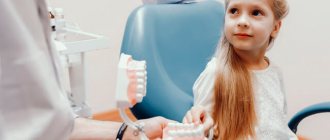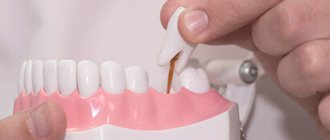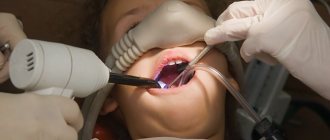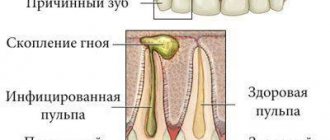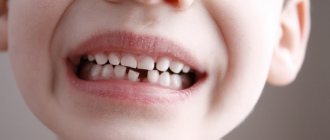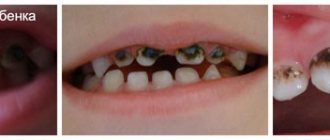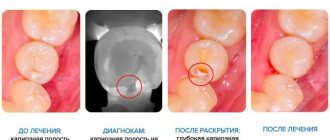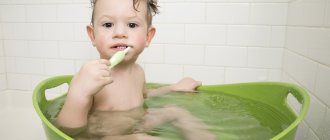“Mom, I want a big chocolate!” - the three-year-old child bursts into loud hysterics throughout the store. The blushing mother, embarrassed in front of the public, hastily buys what she needs. The situation repeats itself constantly and is aggravated, moreover, by the love of adults who strive to treat the baby with something tasty. And after a while, the baby begins to complain of toothache... But sweets are only one of the reasons why caries occurs in children’s baby teeth; Olga Dzedzits, a leading specialist in pediatric dentistry at Inpromed in Moscow, told us about other possible reasons.
How to identify milk caries?
It is quite simple to identify caries in young and older children. White or brown spots appear on the teeth, a painful reaction to hot and cold is observed, and the child may develop bad breath. When these first symptoms of caries appear, it is already worth sounding the alarm, since the carious process is developing very rapidly. It is characterized by almost instantaneous damage to several teeth, and if measures are not taken, the entire dentition may be affected. Of course, it is often difficult for a child to articulate that his baby tooth hurts. He may refuse to eat or chew on only one side. This should also alert parents and encourage them to take their child to pediatric dentistry.
Should I go to the dentist if my teeth are fine?
Regular preventative dental examinations are needed not only for adults, but also for children. Moreover, in childhood they are required even more often. If adults are advised to visit a doctor every six months, then children, due to the characteristics of tooth enamel and potential risks, should visit a doctor every three months.
In addition, parents should visit an orthodontist when their baby’s teeth begin to change. The specialist will conduct an examination,, if necessary, prescribe an x-ray of the oral cavity and recommend treatment that will help the permanent teeth grow evenly and in their places. This means your child’s smile will be beautiful and healthy.
What are the causes of caries in primary teeth?
There are more reasons for caries of baby teeth in children than meets the eye. This includes improper oral hygiene, sharing cutlery with adults who have caries, and much more. However, the main causes of occurrence are the influence of consumed carbohydrates that destroy the tooth, accidental infection from a carrier of a carious infection, a genetic factor, the immaturity of the children's skeletal system, and improper use of pacifiers and nipples.
- Of course, the main and most common cause of caries in primary teeth in children is poor oral hygiene and the influence of sweets. According to statistics, caries develops in young children in 73% of cases. Sucrose, glucose and fructose are the acids that are formed during the fermentation of carbohydrates and lead to the destruction of enamel. Immediately after ingestion of carbohydrates, the pH of saliva decreases from 6 to 4, and pathogenic bacteria settle in food debris that is not cleaned from the teeth.
- Remember the children's saying “from mouth to mouth you get a germ”? It turns out that she is not so far from the truth. The fact is that caries is an infection, an infection. That is, a loving parent, being a potential carrier of carious microbes, does not even suspect that by kissing his baby or sharing dinner with him, he can personally infect his child!
- Another reason why caries may occur on baby teeth is genetic. Teeth begin to form during the prenatal period, in the first trimester of pregnancy. Therefore, smoking by a negligent parent, her illnesses suffered during this period, or taking medications can lead to disruption of the proper development of the child’s teeth.
- Childhood caries of primary teeth may be associated with the following factor: children’s teeth have a low degree of mineralization and erupt “immature”, and only then “mature” in the oral cavity. Final mineralization lasts for one and a half to two years for baby teeth and about three years for permanent ones. Pediatric dentists call such periods of “maturation” the most susceptible to caries. Therefore, the reasons why caries occurs in primary teeth at an early age may also be chronic diseases, the effects of medications, the composition of saliva and the fluoride content in water and food.
- Another cause of caries of primary teeth in young children is improper use of pacifiers. A baby who falls asleep with a bottle in his mouth runs the risk of getting caries on his front teeth, so-called bottle caries. In this case, prolonged contact of the sweet liquid with the teeth leads to caries of all front teeth. In this case, the disease spreads around the entire visible part of the tooth along the perimeter.
As you can see, there are more than enough reasons for the appearance of childhood caries in baby teeth. But they all boil down, as a rule, to demineralization of teeth and destruction of hard tissues. Characteristic changes occurring in teeth can only be diagnosed by a dentist. Further treatment will depend on how severe the caries has developed. What are the stages of development of caries in primary teeth?
Anesthesia in pediatric dentistry, types
1. Application of local anesthesia
Most often used. It is carried out in 2 stages - “freezing” with a gel or spray, after which the drug is injected. Typically, children of any age tolerate this type of anesthesia well. Sensitivity is not completely lost; minimum contraindications.
2. Use of sedation
A sedative is inhaled. The child relaxes, but remains conscious. This is not anesthesia in its “pure form”; there is no strong analgesic effect. It is often used with an injection of an anesthetic drug.
3. Use of general anesthesia
It is used in extreme cases, because the risk of complications after dental treatment under general anesthesia exceeds that with local anesthesia. The pediatric dentist must have good reasons for using general anesthesia, because this causes profound depression of the nervous system, which can be followed by complications. The primary thing is to correctly calculate the dosage and take into account the individual characteristics of the small patient.
The anesthetic drug is given by inhalation: by inhaling the vapor of the drug, the child falls asleep. The doctor gets the opportunity to quickly and calmly treat the tooth, and the child will not feel pain or get stressed.
Stages of caries of primary teeth
Dentists distinguish the following stages of caries of primary teeth in children:
- Elementary;
- Surface;
- Average;
- Deep;
Initial caries of primary teeth
Initial caries of baby teeth can be recognized as follows: white spots of different shapes and sizes appear on the enamel, but there is no pain. In an “advanced” case, the initial caries progresses - the spots darken, becoming brown and then black.
Superficial caries of primary teeth
With superficial caries of primary teeth, the dental tissue defect is located within the enamel, and the carious cavity can be either light or dark. However, in this case, pain occurs when the tooth comes into contact with sweet, sour or salty foods. In this case, treatment of the baby tooth and filling of the cavity is already required.
Average caries of primary teeth
Average caries of primary teeth affects the enamel and internal dental tissue, dentin. In addition to the unpleasant sensations from sweet, sour and salty, pain from hot and cold is added. In this case, just as with superficial caries of primary teeth, filling is necessary.
Deep caries of baby teeth
With deep caries of primary teeth, the enamel and a significant part of the dentin are affected. If treatment is not carried out at this stage, then caries can affect the pulp of the tooth and then reach the root, often causing a cyst in baby teeth. Here you just need to see a doctor before the infection goes further. In this case, severe caries of primary teeth and its treatment will depend on how deep the caries has spread.
Alternative to general anesthesia
The safest alternative is sedation. Through a mask, the patient inhales a mixture of oxygen and nitrous oxide. A slight relaxation and drowsiness appears, and the feeling of fear disappears. At the same time, the child is conscious and able to do what the doctor says.
Sedation cannot be considered anesthesia in the full sense, but it still provides an analgesic effect, and in combination with an injection of an anesthetic it provides a good result. The gas composition is supplied through a device that controls the dose of the mixture, the time of sedation, allowing you to smoothly enter and exit “half-sleep”. After stopping the supply of the mixture, the effect lasts about 10 minutes.
Is caries treated in baby teeth?
Is it necessary to treat caries on baby teeth? This question still remains open for some parents. Even knowing that the child has caries, they are in no hurry to see a doctor, thinking as follows: “the milk teeth will fall out anyway.” Such judgments are absurd, because infected baby teeth will lead to complications in the growth of permanent teeth or provoke an exacerbation of other diseases in the baby’s body. One way or another, you will have to remove the baby tooth ahead of time. Caries in pediatric dentistry is considered one of the most common diseases, so both parents and specialists should ask the question “why is it necessary to treat caries of primary teeth?” Dentists believe that treatment of caries in a baby tooth will preserve it until the “arrival” of the molars.
Experts' opinion
The complex composition of ASEPTA Baby toothpaste allows you to simultaneously care for your gums and teeth. The product has:
- Certificate of state registration;
- Certificate of conformity No. ROSS RU. AG81.H01070.
The paste does not contain fluoride and does not require consultation with a doctor before use. The product is safe if swallowed, as it does not contain components harmful to the health of the baby.
Sources:
- Report on determining/confirming the preventive properties of toothpaste “ASEPTA PLUS” GENTLE WHITENING” Author: doctor-researcher A.A. Leontyev, head Department of Preventive Dentistry, Doctor of Medical Sciences, Professor S.B. Ulitovsky First St. Petersburg State Medical University named after. acad. I.P. Pavlova, Department of Preventive Dentistry
- Report on the determination/confirmation of the preventive properties of personal oral hygiene products “ASEPTA PLUS” Remineralization doctor-researcher A.A. Leontyev, head Department of Preventive Dentistry, Doctor of Medical Sciences, Professor S.B. Ulitovsky First St. Petersburg State Medical University named after. acad. I.P. Pavlova, Department of Preventive Dentistry
- Clinical experience in using the Asepta series of products Fuchs Elena Ivanovna Assistant of the Department of Therapeutic and Pediatric Dentistry State Budgetary Educational Institution of Higher Professional Education Ryazan State Medical University named after Academician I.P. Pavlova of the Ministry of Health and Social Development of the Russian Federation (GBOU VPO RyazSMU Ministry of Health and Social Development of Russia)
Treatment of caries of primary teeth in children
If the doctor finds that a child has incipient caries, then most likely, treatment of baby teeth will not be required. The specialist will protect the enamel from further destruction using a painless and effective procedure - applying fluoride varnish or a silver fluoride compound. Then, when the baby gets permanent teeth, the dentist can seal the fissures - the depressions between the elevations of the tooth - which will prevent the occurrence of bacterial plaque that destroys the enamel. If caries progresses, you can no longer do without filling. The doctor will quickly and almost painlessly remove the affected tissue and hermetically seal the tooth. Otherwise, caries can develop into pulpitis in a child, and then into periodontitis.
Stages of treatment of caries of primary teeth
- Before administering anesthesia, the doctor must numb the injection site using special gels or spray. Moreover, the content of the anesthetic component should be minimal. Anesthesia is, as a rule, carried out only in cases where pulp removal is required - that is, with medium and deep caries of primary teeth.
- It is advisable to remove affected tissue using hand tools or a drill, taking frequent breaks.
- As fillings, materials that can be applied “one time” should be used in order to reduce the operation time.
- If a child has deep caries of primary teeth and its treatment requires the necessary filling of the roots, then the canals are disinfected without special mechanical treatment and filled with a special paste.
- Treatment of baby teeth in children should take no more than half an hour, otherwise the child will get tired.
- Treatment of severe caries of primary teeth, as a rule, takes place in several stages and requires the use of sedation.
- Dental treatment under general anesthesia in children is carried out strictly according to indications;
You can get rid of carious lesions at the initial stage using modern methods of caries treatment without a drill. Comfortable, painless treatment is suitable for those children who are afraid of manipulation with a dental bur. The cost of treating caries in baby teeth without a drill is slightly higher than the price of traditional dental treatment for children, but it is worth it. If simple caries gives complications, then you will have to resort to classic drilling. The cost of treatment of complicated caries of primary teeth will depend on the degree of neglect of the disease.
Dental status of children
The condition of the oral cavity directly affects the entire body:
- pathological changes can lead to malfunctions of internal organs (kidneys, gastrointestinal tract) and the appearance of diseases;
- with an incorrect bite, breathing through the nose is impaired, which leads to dysfunction of organs and organ systems;
- caries and the complications caused by it cause sore throat and other diseases, the causative agents of which are streptococci, which cause carious changes in the teeth.
The body characteristics of young children and their underdeveloped immune system determine that they are at risk for developing diseases. Since the body is a single interconnected whole, the condition of the oral cavity is given the same close attention as other organs. That is why WHO has proposed that dental examinations be carried out according to a specific schedule. If a child has a toothache, an immediate unscheduled visit to a pediatric dentist is necessary for an examination and prescription of a course of treatment.
Prevention of caries in children
Prevention of childhood caries includes several areas, which boil down to proper nutrition, as well as home and professional hygiene.
- Individual oral hygiene. Home hygiene means that as soon as the first tooth hatches, a brush for the baby should appear in a glass next to the parents’ brushes. The same applies to toothpaste. At first, the paste can be applied to gauze or a fingertip to clean your teeth so as not to injure your delicate gums. You need to clean your teeth from all surfaces vertically, then wipe them with a brush soaked in water. Thus, firstly, plaque will be removed, and, secondly, parents will teach the baby to take care of the oral cavity.
- Prevention of caries with the help of a well-chosen diet. As for nutrition, parental duty is to breastfeed the baby from the very beginning. There is no need to talk about the beneficial properties of breast milk, and the sucking process greatly affects the developing jaw system. Then the baby should be accustomed to fermented milk products. By six months, the child should be fed kefir, and later - cottage cheese and cheese. Parents should remember that the main formation and formation of permanent teeth occurs up to 3 years. This means that calcium must always be present in the daily diet.
- Professional oral hygiene. This type of prevention involves periodic visits to the dentist and hygienist. The first visit should occur on your first birthday. The specialist will not only give recommendations for care, but also create a diet regimen and examine the mouth. When the first teeth emerge, you and your child will be shown how to brush their teeth properly at an appointment with a hygienist. If there is a problem such as tartar in children, you cannot do without professional hygienic cleaning. It is important for parents to make it a rule to visit the doctor twice a year. And if there are problems with teeth, then more often - once every three months. This is largely due to the fact that various pathologies develop too quickly in childhood. Meanwhile, early diagnosis will lead to quick, painless and relatively inexpensive treatment of caries.
As you can see, in most cases, when caries can attack children's teeth, parents are able to rebuff it decisively. Of course, there is no escape from genetic predisposition. But it’s not without reason that dental experts say that sweets are the main cause of the development of the disease! So isn’t it better to eliminate the constant source of bacteria and, instead of harmful carbohydrates, offer the child fruits, which are much healthier, after the main meal? Ultimately, your child will thank you in the future for being vigilant and maintaining healthy teeth!
Make an appointment
right now!
Dzedzits Olga Alekseevna
Surgeon, Therapist, Pediatric dentist, Hygienist
How to prepare a child for treatment?
Children intuitively feel the fear of adults and begin to be afraid of dentists even before their first glance at the dental chair. In order for the treatment of caries in a baby under 3 years old to go as smoothly as possible, it is necessary to prepare him for a visit to the doctor in advance.
- Find a trusted, good dentist who can establish contact with your child.
- Take your child for preventive examinations to the dentist, do not wait until the tooth hurts. Believe me, pain will greatly increase children's fear.
- Be calm at your doctor's appointment. Remember, all the fears of the parents are transmitted to the baby. There is no need to tell the child “don’t be afraid”, “it won’t hurt”, “like a mosquito will bite” even before he approaches the doctor.
- If your baby is already playing on his own, rehearse your visit to the dentist at home. Treat caries for a bear, bunny, or cat. Let your child get used to the atmosphere of the dental office a little.
- Tell your child that everyone goes to the dentist - mom, dad, and grandparents. And, most importantly, emphasize that visits to the doctor bring joy and relief to everyone.
- Choose a time to visit the doctor when your child is alert and cheerful. Believe me, the baby will not be happy to be in the doctor’s chair during the daytime nap or in the evening when he is already tired. By the way, during the visit the baby should be well-fed.
- If you nevertheless went to the dentist for the first time because of a toothache, convince your child that the doctor will definitely help him. Remember, the baby is already very scared, so there is no need to use the words “drill” or “acute pain”. Better tell a story about how a good doctor will save a child from carious monsters, and his teeth will become white and healthy.
We hope our tips for treating caries in children under 3 years of age will be useful to you. Teach your child not to be afraid of dentists and to take care of their teeth. May you and your children always have beautiful snow-white smiles.
And in order for a child to love brushing his teeth from a very early age, it is important to choose a tasty, high-quality toothpaste for him. ASEPTA baby toothpaste gel-paste is created specifically for children aged 0 to 3 years. The soft, sweet gel carefully cares for the child’s teeth and gums without damaging them, and the natural components of the paste provide protection against caries and inflammatory processes in the oral cavity.
The paste does not contain abrasives, fluorine, parabens, or sodium lauryl sulfate, so it is absolutely safe for crumbs. And the bright taste of “tutti-fruiti” will make brushing your teeth very pleasant for your baby.
Caries on the front milk teeth - what to do?
On the front milk teeth, caries occurs almost as often as on the lateral ones. What should the child’s parents do in such cases? Be sure to take him to the dentist, regardless of the stage of the disease. Even if you notice a white spot on your baby’s front teeth, do not delay visiting the doctor to avoid further development of caries, its complications and other unpleasant consequences that pose a threat to the health of the child’s future permanent teeth.
Caries of primary teeth and its ENT complications
Sometimes parents unsuccessfully try to understand why their child often suffers from colds, complains of ear pain, and suffers from a chronic runny nose. And few people realize that the reason for weakened immunity lies in the baby’s untreated teeth. How can this be? It turns out that it’s all about pathogens! Caries develops under the influence of pathogenic bacteria, which can also cause diseases of the gastrointestinal tract and respiratory system of the child. Therefore, timely treatment of caries is important, including for maintaining the normal functioning of other organs of the baby.
Do baby teeth hurt due to caries?
Painful sensations when the surface of the teeth comes into contact with sweet, sour or salty food irritants is one of the first signs of incipient caries on baby teeth. Further, the discomfort in the affected teeth will only intensify, and when caries affects the pulp, the teeth begin to hurt like adults. In addition to acute pain, this stage of the disease is characterized by a high risk of premature removal of a baby tooth.
Publisher: Expert magazine about dentistry Startsmile.ru
